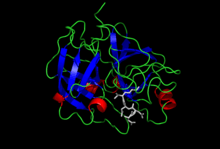Enteropeptidase
| enteropeptidase | |||||||||
|---|---|---|---|---|---|---|---|---|---|
 Crystal structure of Enteropeptidase with an inhibitor | |||||||||
| Identifiers | |||||||||
| EC number | 3.4.21.9 | ||||||||
| CAS number | 9014-74-8 | ||||||||
| Databases | |||||||||
| IntEnz | IntEnz view | ||||||||
| BRENDA | BRENDA entry | ||||||||
| ExPASy | NiceZyme view | ||||||||
| KEGG | KEGG entry | ||||||||
| MetaCyc | metabolic pathway | ||||||||
| PRIAM | profile | ||||||||
| PDB structures | RCSB PDB PDBe PDBsum | ||||||||
| Gene Ontology | AmiGO / EGO | ||||||||
| |||||||||
| protease, serine, 7 (enteropeptidase) | |
|---|---|
| Identifiers | |
| Symbol | PRSS7 |
| Entrez | 5651 |
| HUGO | 9490 |
| OMIM | 606635 |
| RefSeq | NM_002772 |
| UniProt | P98073 |
| Other data | |
| Locus | Chr. 21 q21 |
Enteropeptidase (also called enterokinase) is an enzyme produced by cells of the duodenum and involved in human digestion. It is secreted from intestinal glands (the crypts of Lieberkühn) following the entry of ingested food passing from the stomach. Enteropeptidase converts trypsinogen (a zymogen) into its active form trypsin, resulting in the subsequent activation of pancreatic digestive enzymes.[1][2]
Enteropeptidase is a serine protease (EC 3.4.21.9) consisting of a disulfide-linked heavy-chain of 82-140 kDa that anchors enterokinase in the intestinal brush border membrane and a light-chain of 35–62 kDa that contains the catalytic subunit.[3] Enteropeptidase is a part of the chymotrypsin-clan of serine proteases, and is structurally similar to these proteins.[4]
Activity
Despite its alternative name, enteropeptidase is a serine protease that catalyses the hydrolysis of peptide bonds in proteins. Enteropeptidase exhibits trypsin-like activity, cleaving proteins following a lysine at a specific cleavage site (Asp-Asp-Asp-Asp-Lys).[5] As the pro-region of trypsinogen contains this sequence, enteropeptidase catalyses its activation in vivo:
trypsinogen → trypsin + pro-region (Val-Asp-Asp-Asp-Asp-Lys)
Genetics
In humans, enteropeptidase is encoded by the PRSS7 gene (also known as ENTK) on chromosome 21q21. Some nonsense and frameshift mutations in this gene lead to a rare recessive disorder characterised by severe failure to thrive in affected infants, due to enteropeptidase deficiency.[6]
Applications
Enteropeptidase's specificity makes it an ideal tool in biochemical applications; a fusion protein containing a C-terminal affinity tag (such as poly-His) linked by this sequence can be cleaved by enteropeptidase to obtain the target protein following protein purification.[5] On the converse, the N-terminal pro-sequence of proteases that must be cleaved prior to activation can be mutated to enable activation with enteropeptidase.[7]
References
- ↑ Kunitz M (March 1939). "Formation of trypsin from crystalline trypsinogen by means of enterokinase". J. Gen. Physiol. 22 (4): 429–446. doi:10.1085/jgp.22.4.429. PMC 2141988. PMID 19873112.
- ↑ Kiel B (1971). "Trypsin". In Boyer PS. The Enzymes, 3: Hydrolysis - Peptide Bonds. Amsterdam: Elsevier. pp. 249–275. ISBN 0-12-122703-0.
- ↑ Huang L, Ruan H, Gu W, Xu Z, Cen P, Fan L (2007). "Functional expression and purification of bovine enterokinase light chain in recombinant Escherichia coli". Prep. Biochem. Biotechnol. 37 (3): 205–17. doi:10.1080/10826060701386695. PMID 17516250.
- ↑ Rawlings ND, Barrett AJ (February 1993). "Evolutionary families of peptidases". Biochem. J. 290 (1): 205–18. PMC 1132403. PMID 8439290.
- ↑ 5.0 5.1 Terpe K (2003). "Overview of tag protein fusions: from molecular and biochemical fundamentals to commercial systems". Appl Microbiol and Biotechnol 60 (5): 523–33. doi:10.1007/s00253-002-1158-6. PMID 12536251.
- ↑ Holzinger A, Maier EM, Bück C, Mayerhofer PU, Kappler M, Haworth JC, Moroz SP, Hadorn HB, Sadler JE, Roscher AA (January 2002). "Mutations in the proenteropeptidase gene are the molecular cause of congenital enteropeptidase deficiency". Am. J. Hum. Genet. 70 (1): 20–5. doi:10.1086/338456. PMC 384888. PMID 11719902.
- ↑ Wang ZM, Rubin H, Schechter NM (Nov 1995). "Production of active recombinant human chymase from a construct containing the enterokinase cleavage site of trypsinogen in place of the native propeptide sequence". Biol Chem Hoppe Seyler 376 (11): 681–84. PMID 8962677.
External links
- Enteropeptidase at the US National Library of Medicine Medical Subject Headings (MeSH)
| ||||||||||||||||||||||||||